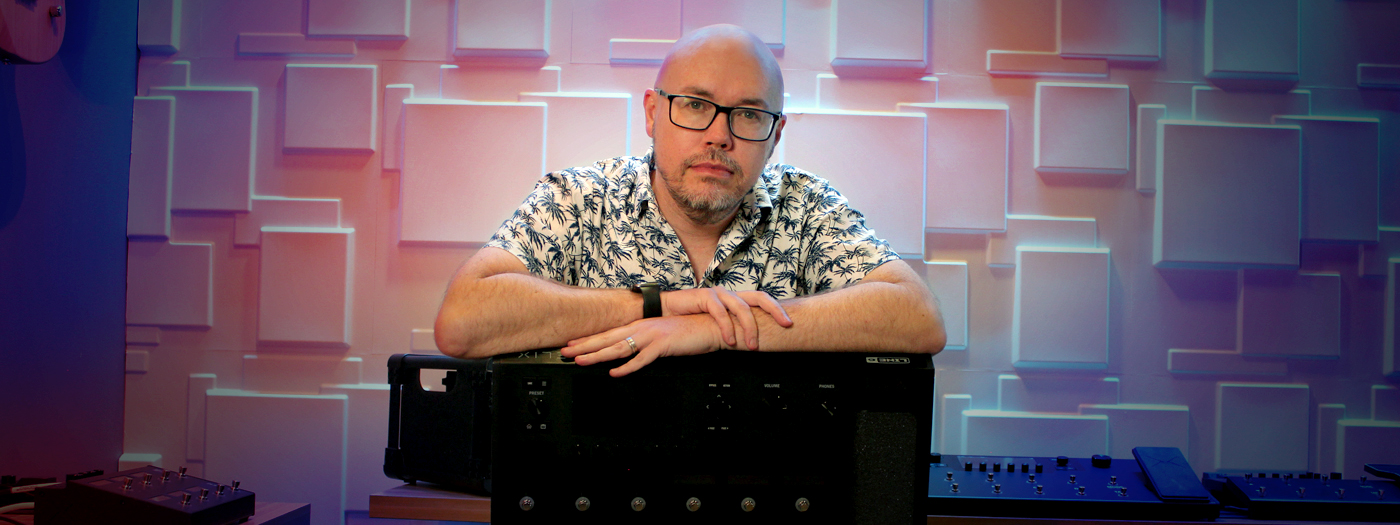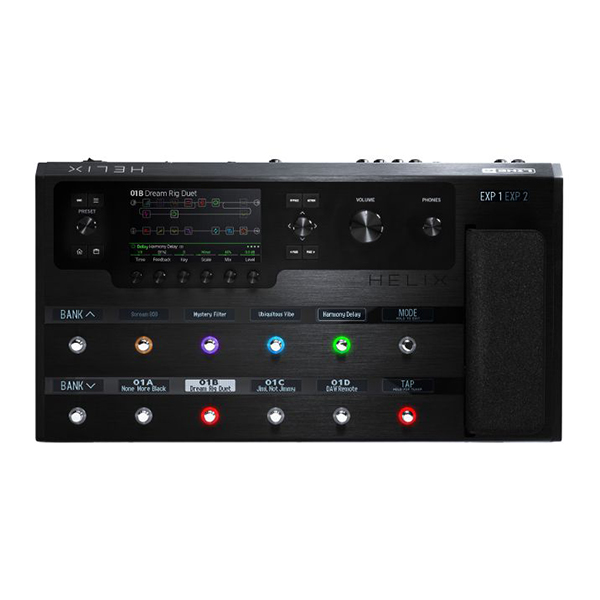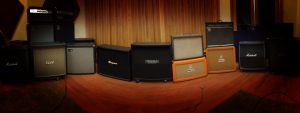Eric Klein: At Least Half of Your Modeler’s Sound Is Determined by Your Playback System
by Eric Klein
When you read the phrase “sound of a Marshall JCM800,” what is the first thing that pops into your head? Are you standing in front of a half stack? Maybe seeing a certain band at a large venue downtown? Listening to a particular recording while on a road trip?
There’s no wrong answer, yet the experience of hearing the JCM800 in each of these environments couldn’t be more different.
Although many of us in the industry loathe the term, in the first example you’re experiencing what is known as the “amp in the room.” (I dislike this term if only because it should be “cab in the room.”)
The guitar speaker and the cabinet it is in vibrate air molecules, which propagate in sound waves that vibrate your eardrums. Chances are the strongest vibrations hit your knees, unless you’re facing a full stack. And if you’re smart, you’re not turning the Master Volume knob past halfway.
In smaller venues, the band may be on a five-foot stage, so the cab is pointing toward your face. Or it could be across stage pointing somewhere completely different. In large venues, the sound of the guitar is mostly coming from a P.A. system, via a microphone pointed at the cab’s speaker and run through the front-of-house console.
When you listen to your favorite records, the room in which the guitar amp was recorded, the microphone used to record it, the placement of the mic, the mic preamp and any other outboard gear used, the analog-to-digital conversion, digital processing, mixing (especially when trying to get the guitar to sit right with the rest of the instruments), and mastering can and do drastically change the sound. What you hear is likely totally different than what the guitarist experienced that day in the session. Now consider the myriad methods of listening to that recording—from cassette decks in older cars to budget Bluetooth earbuds on your morning jog to $100,000 audiophile systems in acoustically neutral listening rooms.
It is also common for session guitarists to place the cab in the tracking room, but play from the studio control room, listening through studio monitors along with the producer and engineer. This lets them crank the amp’s volume to hit its sonic sweet spot while avoiding ear damage. In other cases, they may forego the cab altogether and run the amp (again, with the Master Volume louder than they’d normally play through the cab) into an attenuator/load box and utilize cabinet emulation or IRs (impulse responses).
So, which of these is the “sound of a Marshall JCM800”? All of them. The amplifier hasn’t changed—but the playback systems and environments are completely different.
Your playback system and listening environment account for at least 50% of your tone and well over 50% of your experience.
Okay, so it’s the playback system. Can’t modelers fix bad playback systems?
I’ll answer that question with another question: Can’t turntables convince you your favorite band is actually playing in your house?
A better turntable can’t convince you the drummer is behind you, the singer is in your kitchen, and the bass player is passed out behind the sofa. At the very least, you’d blame your decidedly non-Dolby Atmos home stereo and not your turntable. The point is that all of these pieces of gear—your turntable, your hi-fi amplifier, your surround sound system, their material properties, location in the room, acoustics of the room, playback volume, and others—all perform together as an open system, and a system is only as good as its weakest link.
While modern professional modelers such as Helix Floor can completely nail the sound and feel of end-to-end closed systems like preamps and power amps (to the point where top LA session guitarists and golden ear engineers state they’re indistinguishable from the real thing in double-blind A/B/X listening tests), they have absolutely no clue about—and certainly no control over—what you plug them into. Until the technology exists where we can bypass your ears and tap directly into your brainstem, no amount of digital trickery will ever enable a 1×12″ cabinet to make you believe there’s actually a 4×12″ in the room, much less convince you a plastic P.A. speaker is a wooden cabinet with guitar drivers, or your broken 4″ computer speakers aren’t hot garbage. The laws of physics dictate this, not any lack of DSP sophistication.
So, what’s the right playback system for digital amp modelers?
It depends on what you’re trying to accomplish. Let’s take a look at your options, in no particular order: FRFR speaker, P.A. speaker, headphones/IEMs, studio monitors, standalone power amp/real cab, and real amp/cab.
FRFR Speaker
FRFR stands for Full Range/Flat Response, and they are typically wooden cabinets that look like real guitar cabs, except that there are often two speakers—a low frequency driver (woofer) and high frequency driver (tweeter). They’re designed to be flat and accurate, almost like a studio monitor you can bring to the stage.
Pros:
• A good balance of sound and feel when amplifying a wide variety of cab models or IRs
• Looks like a real cabinet
• The audience hears what you hear on stage
Cons:
• Still may not respond exactly like that one guitar cabinet you know and love, even if it is the same configuration (1×12″, 2×12″, 4×12″, etc.)
• The high-frequency driver can sometimes sound a bit strident (although this can often be dialed out from the modeler’s global EQ)
• More expensive than other solutions
Best For guitarists who want to embrace the wide variety of amps, cab emulations, and IRs found in modelers but don’t want to sacrifice the look of a wooden cab.
P.A. Speaker
Pros:
• More affordable than FRFR speakers generally
• Robust construction
• Often the most convenient, portable solution
• Flexible orientation—many can be used as a stage wedge, upright speaker, or on a speaker stand
• Can sometimes connect additional sources, such as vocal mics and be used for other things, like, say, DJing a wedding
Cons:
• Sounds less like a real cabinet—frequency response is sometimes “hyped” or “scooped” to sound better for music playback—even those marketed for guitars
• Feels less like a real cabinet
• Looks less like a real cabinet
Best For guitarists who may be on a budget, are weekend warriors, or want their playback system to serve double (or triple) duty.
Headphones/IEMs (In Ear Monitors)
Pros:
• Clearly the most convenient and portable option
• May be easier to hear detail, especially in noisy environments
Proper IEMs are what most large touring acts are using these days
• In larger venues, you hear what the audience hears
Cons:
• Massive range of quality, from excellent (high-impedance over-the-ear open-backed studio headphones) to hot garbage (low-impedance consumer earbuds)
• Sound and feel very little like playing through a real cab
Best For guitarists who want to practice or rehearse on the go, live in apartments or for other reasons can’t play through loud speakers, embrace “silent stage” monitoring, or are comfortable with how recorded guitar sounds (as opposed to how cabs sound in the room).
Studio Monitors
Pros:
• Better studio monitors typically have the flattest, most-accurate frequency response (provided they have enough bass)
• Your writing/rehearsing tones will most closely match your recorded tones, making it easy to transfer sounds from studio to stage and back again
• If you record, you probably already own them!
Cons:
• Unless you splurge for studio monitors with 8″ or larger woofers, the low end may be lacking
• May not be loud enough for practicing with others or gigging (unless you play coffee shops)
• Feels less like a real cabinet
• Not meant for live performance
Best For guitarists who spend most of their playing time in the studio and are comfortable with how recorded guitar sounds (as opposed to how cabs sound in the room).
Standalone Power Amp and Real Cab
A power amp doesn’t need to be a big rackmount affair. There are several compact pedalboard-based power amps that can drive guitar cabinets.
Pros:
• Real cabinet response and feel
• Looks great on stage
Cons:
• Often larger and heavier
• Power amp response may not be exactly what you’re expecting
• More difficult to stray from the inherent sound of that particular cab (which may not be a bad thing)
Best For guitarists who love the sound and feel of their real cabinet, but are looking for a wider variety of preamp and power amp sounds.
Real Amp and Cab
That’s right! There’s absolutely nothing stopping you from using amp modeling with real amps. And depending on how you hook it up, you may be able to use both your amp’s preamp and your modeler’s preamps, even blended together at the same time. (A friend of mine played in a Metallica cover band with Laney amps and they used to rent Roland JC-120s just for the first half of “Nothing Else Matters.” With Helix via 4-cable method, they were able to swap the real Laney preamp for the modeled JC-120 preamp with a single footswitch press.)
Pros:
• Sounds and feels exactly like the amp and cab that you love
• Looks great on stage
• 4-Cable Method setups still allow for instantly swapping out your amp’s preamp section (if and when desired)
Cons:
• Often much larger and heavier—may not fit in your mom’s Prius
• Least variety of distinctly different tones—more difficult to stray from the inherent sound of that particular amp and cab (which may not be a bad thing)
Best For guitarists who embrace one particular amp but would like a bit more flexibility, or care less about modeled amps but love the power and flexibility of digital multi-effects.
There are also Line 6 Powercab active guitar speaker systems, which are different than all of these. They combine a powered wooden guitar cabinet with the ability to virtually swap out different drivers. But just like every other playback system, Powercab 112 Plus or 212 Plus can’t convince you that you are playing through, say, a 4×12 cab—though they can convince you it’s that particular 1×12 or 2×12 cabinet with different speakers. And they can also be set to function as excellent FRFR speaker systems.
What can I do to make my playback system behave more like a real cab?
1. Start out with the model of an amp and cab combination you know well. If you’ve never played through a real Revv Generator 120 or Grammatico GSG100, there’s no baseline from which to compare.
2. An amp model’s default values often have the Master parameter turned up, because that’s where the real amp’s sweet spot is. However, tube amps are loud so if you’re playing at bedroom volumes, of course it won’t sound like a roaring full stack. Turn your playback system up!
3. If you can’t (or aren’t allowed to) play at louder volumes, turn the Master parameter down (if your modeler has one) to approximate your playback system’s level.
4. Try placing your playback system in the same location in the room and point it in the same direction as you would a real cab. Most cabs are mono and point at your legs, they don’t point at your face in stereo.
5. In the cab block, experiment with different microphones at different distances and positions. (Or with IRs, choose one with a different microphone, distance to the speaker, and position.) Condenser microphones at a greater distance tend to sound more amp-in-the-room, whereas a Shure SM57 right up against the grille will more closely approximate what you might hear on a record.
6. Add a touch of ambient reverb to your sound, especially when using headphones. A little goes a long way here.
Lastly, a favor: Whether online or in meatspace, the next time you encounter a new user struggling with amp modeling, before you start rattling off suggestions like adding low-cut filters, downloading different IRs, changing the input buffer, etc., try the following:
1. Ask them what their expectations are. Are they expecting to get the feel of amp-in-the-room or the sound from a particular record? Do they have experience in front of one specific cab and are they chasing that?
2. Ask them what their playback system is. Chances are it is not a real cab. It might be something particularly egregious like a plastic PA speaker, smaller studio monitors, or headphones.
3. Share this post with them!

Eric Klein is Chief Product Design Architect at Yamaha Guitar Group, trolls several gear forums via the handle Digital Igloo, and if you ask nicely, will show you nine thousand pictures of his two dogs, Bill&Ted and Paddles.
Related posts
Leave a Reply
You must be logged in to post a comment.
By submitting your details you are giving Yamaha Guitar Group informed consent to send you a video series on the Line 6 HX Stomp. We will only send you relevant information. We will never sell your information to any third parties. You can, of course, unsubscribe at any time. View our full privacy policy







I’m totally sold on Powercab, I have 2, a 112+ and 212 for different venue needs. The reason is that Powercab can cover many of the playback systems Eric describes. It can do FRFR pretty well, and I use that for acoustic guitar tones in every gig (I also use a Variax JTV69S a lot). It can model other speakers, but I don’t find this feature that useful. It’s ok, but not great. But it can also play the role of a powered guitar cabinet by using Flat/LF Raw mode. I find the speaker in Powercab112+ to be a pretty nice guitar speaker, comparing well with multiple Celestion options I have. This is how I use Powercab to get the amp in the room sound while also having the option for many other tones through FRFR.
Excellent post. Been using Helix since it first came out in 2015. I’ve gone back and forth, a few times, between full amp modeling with FRFR, PA Speaker and In-Ears, and then no amp modeling using Helix only for the effects through real tube amps. There’s beauty in both methods and I think it’s a skill to develop how to play and perform with either. I’ve learned so much about tone sculpting and sound engineering through using the Helix and it’s amp and effects models. It’s made my ability to understand how to find the tones I’m going for, much better. I’m continually learning which playback system is the most inspiring for me and after 4 years of going direct and using in-ears, I’ve purchased a Princeton Reverb, which sounds wonderful, when it front of it, but very little if any difference when mic’d and run through a PA speaker. My current favorite playback system is a QSC k10 monitor. though there’s many out there that haven’t tried, that I would like to. Thanks for the great article!
Thanks for a great article. I’ve been a Helix fan since they came out (and all the PODs before that) and struggled with this issue for a long time. I bought a Powercab 112 a couple of years ago, and this solved the problem completely. ( I’m into the amps that use 1 x 12 cabs, mostly, so it works well.) I’m getting the amp tones of my dreams with this setup and the new Grammatico GSG amp model.
When I have to use headphones, I plug a pair of Sennheiser HD 380 pros into the Helix Floor.
This is a great post and spot on.
I often wonder if I really “know” what my favorite artists sound like in any other setting other than what I hear on the record.
Sometimes I get so overwhelmed with all the options, pros/cons, etc. even after reading this article. Then I go back to my favorite quote from my guitar hero: “If it sounds good, it is.” – Eddie Van Halen.
Keep up the great work Eric!
For me, it is hard to beat the Powercab. Picked up a Variax guitar and Powercab Plus to pair up with my LT a couple years back (with the requisite cables), and the flexibility and options are just endless.
You can’t beat that IMO. And the sound/ feel of the Powercab is on par with “real” amps as well, which is great.
I would love to see another update to the Powercab firmware (hint hint)
This was an excellent post. One that should be at the top of the reading list if one is thinking of going the modeler route such as Helix etc. Most modelers these days offer decent tone options, amps, IRs and fx, but that is only half of the equation. The playback system whatever is chosen will definitely make a big difference good or bad and from my experience is the most difficult decision to make when purchasing a ‘modeler’. If you came from a real tube amp background and play live you maybe somewhat disappointed in trying to replicate that experience. The post above gives you some options that may work out good enough. But I found it was the trial and error method which you might have to go through in order to get something you are happy with. To me, skipping the modelers IRs/Cabs and going with a real guitar cab/speaker (of choice) and a clean type power amp makes the most sense for those who want a more realistic experience that you might have had with real tube amps. One thing is for sure you will probably not have a smaller footprint overall for a ‘live’ setup. But the versatility of a modeler for a cover type band or for your own compositions is really helpful if you dive into the settings etc. I think the FRFR option is overrated, but in some instances with the right setup may work.
Eric – Thanks for the post. I”m with you on the “Real Amp & Cab”. I’d say, if you want the sound of an amp in the room, then play through an amp in the room, and crank it up. I run my Helix primarily in 4CM mode with two combo amps; both have EVM 12L speakers, and that works great for me. One comment on your Cons: “least variety of distinctly different tones” … with a speaker like the 12L, I play my combo pre as well as all the Helix amp models, usually without cab models, but sometimes things just sound better with cab models. I’m pretty satisfied that I get very wide variety of tones! Lastly, regarding your “Best for” comments on this one … I personally embrace several of the Helix’s amp models, and they all sound great to me using this config. To me, this config is the best of all worlds. I love it. Thanks again for the post. -Mark
The best article from master Klein! I’ve been using Helix since 2019. I’ve learned a lot and in still learning…guess there’s no end for this journey. I’ve tried many playback options. First I used a marshall transistor amp but the speaker was poor quality. Then I swapped to active alto speakers. They sounded better and great and wonderful with stereo presets. I could use them as Eric explained playing with backing tracks. However I sold them because I can’t play loud at my apartment and I realized you must have good quality and expensive professional PA speakers for better results. I bought a pair of JBL studio monitors and this is the better option for practicing at home, studio recording and programming my presets. Then when I started to play live at medium and small venues I begun to struggle with some issues. My partner uses a Marshall JVM tube amp and my small PA speakers were crap..lol. I bought a line 6 Powercab and It sounded great at home but playing with the band in rehearsals the sound was too “harsh” at louder volume. My powercab was not the plus model. Unfortunately I live in south America and dealers don’t sell 112 plus and 212 🙁 Finally I decided to build a custom fatbaby real cab with a Celestion V30 speaker combined with a Harley Benton gpa 100 Poweramp and that’s my stage monitor and rehearsing rig. But at the very end my main playback system are Sennheiser wireless IN EARS monitors and an XLR direct to FOH …Ha Ha Ha ..,! Greetings from Chile !!!